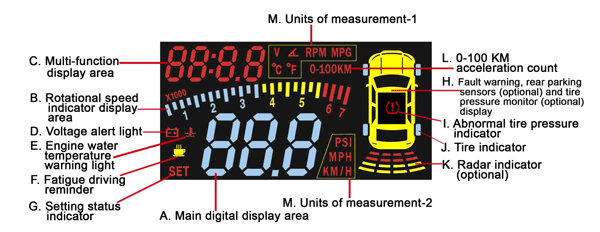|
Functions
1.
This
product is an OBDII interface multifunctional HUD, with simple installation which
you don't need to break the car’s original circuits to use, just plug and play.
2.
Metric
to Imperial conversion, compatible for different standard vehicles.
3.
Comprehensive
information, like Vehicle speed, speed of revolution, clock, MPG, parking distance
control (not included in standard edition), tire pressure (not included in standard
edition) is
displayed on the same screen.
4.
All
numbers displayed, convenient and direct.
5.
Uses
scroll wheel button for more convenience (complete all the settings with one finger)
6.
Smart
alert, with sound and lights for users to choose.
7.
Gear
shift reminding function for new drivers (suitable for hand shift and auto shift
automobiles)
8.
Screen
brightness automatically changes for different environment.
9.
Throttle
angle display, knowing the throttle angle anytime.
10.
Automatic voltage
display after starting engine.
11.
Automatic turn-on
after starting engine and turn-off after shutting down engine.
12.
Uses Cab6.0 soft
flat wire for simple wiring.
13.
Digital Clock
display.
14.
Real-time MPG
display.
15.
Seconds counting
for 0-100 KM acceleration.
16.
Fatigue driving
reminder.
17.
Overspeed alarm.
18.
Low battery voltage
alert.
19.
High water temperature
alarm.
20.
Single driving
time, mileage and average speed display (after shutting down engine)
21.
Error code alarm(after
ignition, when a failure happens, the yellow car on the right side will flash for
10 seconds)
22.
Wireless real-life
voice parking sensor.(optional)
23.
Wireless tire
pressure monitor.(optional)

Screen functions introduction
A.
Main digital display area: Display speed (after ignition), mileage, average speed
(display after turn-off for 5 seconds), reversing distance (radar function optional),
tire pressure value (TPMS feature optional).
B.
Rotational speed indicator display
area: the first bar means 0, each bar represents 250 rpm. When speed is up to 1000
rpm, the number 1 is lit; when up to 2000 rpm, the number 2 lit, and so on.
C.
Multi-function display area: switch the scroll wheel button to display clock, water
temperature, voltage, throttle angle, rotational speed, MPG, closest probe number
(radar functions optional), tire temperature (TPMS feature optional).
D.
Voltage alert light
E. Engine water temperature warning light
F.
Fatigue driving reminder
G. Setting status indicator
H.
Fault warning, rear parking sensors (optional) and tire pressure monitor (optional)
display
I.
Abnormal tire pressure indicator
J. Tire indicator
K.
Radar indicator (optional)
L. 0-100 KM acceleration count
M.
Units of measurement
|